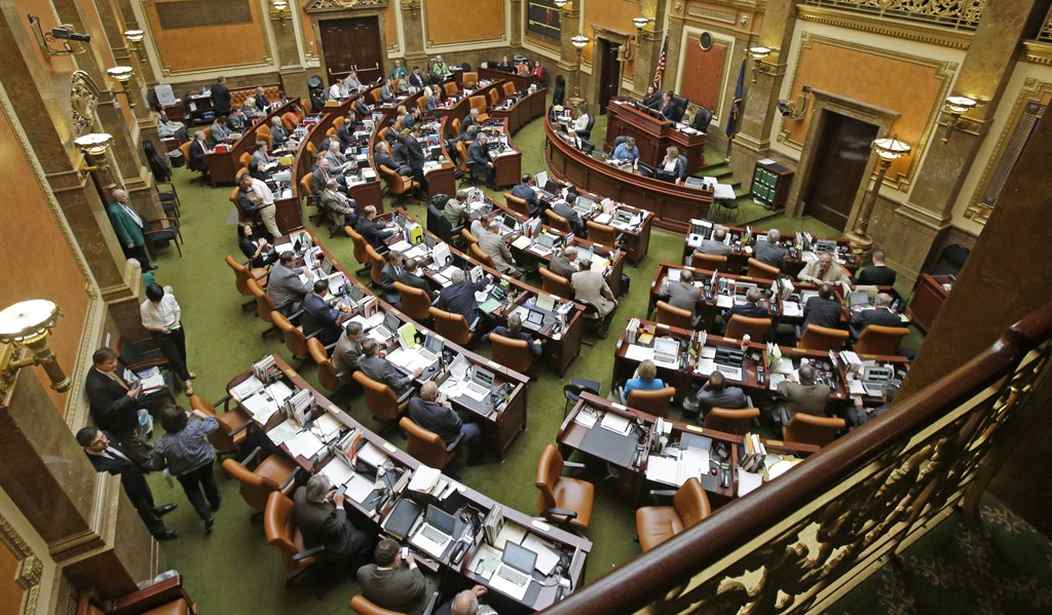The Republican State Leadership Committee (RSLC) has a daunting task ahead: funding a $125 million effort over the next several years to make sure Republicans maintain the dominance they have in their respective states’ legislatures. Right now, two-thirds of the governorships are in Republican hands, and the GOP controls the most state legislative seats since 1920. It’s also these very chambers that draw the congressional lines. As a result of this electoral success, the GOP has a rather wide pool (an ocean really) for the potential for new talent to rise through the ranks. This is something that is notably missing on the Democratic side. In May, The New York Times noted the “crackup” that’s occurring among Democrats below presidential races. The butcher’s bill was quite steep. It showed that the GOP’s potentially generation-long lock on the House is due to the party’s strength in state and local elections:

For all the much-discussed ailments of the Republican Party — its failure to win the popular vote in five of the last six presidential elections; the corrosive bickering between its mainstream and its Tea Party stalwarts; and the plummeting number of Americans who identify themselves as Republicans — the inescapable reality is that the Democrats have fallen into a ditch arguably as deep and dismal as the one Republicans have dug for themselves. “It isn’t that the Democratic Party is struggling,” says Jonathan Cowan, the president of the centrist policy center Third Way. “It’s that at the subpresidential level, it’s in a free fall.” The Democrats lost their majority in the Senate last November; to regain it, they will need to pick up five additional seats (or four if there’s a Democratic vice president who can cast the tiebreaking vote), and nonpartisan analysts do not rate their chances as good. The party’s situation in the House is far more dire. Only 188 of the lower chamber’s 435 seats are held by Democrats. Owing in part to the aggressiveness of Republican-controlled State Legislatures that redrew numerous congressional districts following the 2010 census, few believe that the Democratic Party is likely to retake power until after the next census in 2020, and even then, the respected political analyst Charles Cook rates the chances of the Democrats’ winning the House majority by 2022 as a long shot at best.Things get even worse for the Democrats further down the political totem pole. Only 18 of the country’s 50 governors are Democrats. The party controls both houses in only 11 State Legislatures. Not since the Hoover Administration has the Democratic Party’s overall power been so low. A rousing victory by Hillary Rodham Clinton might boost other Democratic aspirants in 2016; then again, in 2012 Obama won 62 percent of Electoral College votes yet carried 48 percent of Congressional districts and a mere 22 percent of the nation’s 3,114 counties. Through a billion dollars of campaign wizardry, the president did not lift up but only managed to escape a party brand that has come to be viewed in much of America with abiding disfavor.
For a giddy moment seven years ago, Democrats dared to believe that Barack Obama’s election would significantly reconfigure partisan alliances. Instead, his presidency has only calcified them. “When Obama swept the 2008 primary and general elections, Democrats’ image suddenly came to be defined by a city-dwelling law-school professor whose life experiences had been far different from those of most working-class whites,” said David Wasserman, a congressional analyst for The Cook Political Report. “It was the culminating moment of a half-century of realignment. Democrats had already ceded Southern whites, but in the last few years they have lost droves of Midwestern, small-town and working-class whites who feel like they have little in common with the party anymore.”
[…]
Moderates believe the only remedy is for Democrats to refashion themselves as pragmatists who care more about achieving results than ideological purity…
[…]
Progressives, on the other hand, believe that the Democrats lost their way by obsessing over what President Bill Clinton once termed “the vital center.” That fixation, they say, has rendered the party brand incomprehensible and raised the question as to what exactly Democrats stand for. To them, it is the sharp-tongued populist rhetoric of Warren, whose signature line is that “the game is rigged” against working-class Americans, that represents the party’s only viable future.
[…]
The problem is that neither wing can muster an entirely airtight case that theirs is the road map to electoral success.
Recommended
Right now, the window for finding solid Democratic House candidates is closing fast. And the RSLC’s RedMap initiative–the $125 million venture mentioned above–seek to keep Democrats grasping at straws regarding taking over the House, or regaining ground lost at the state-level.

In July, the RSLC announced their $40 million effort to defend gains they made in the various state legislatures, and place news ones in the cross hairs. For 2016, the Democratic controlled Colorado House, Kentucky House, Washington House, Iowa Senate, Minnesota Senate, and New Mexico Senate are being put on notice. According to their press release, the RSLC and the Republican Legislative Campaign Committee (RLCC) are also playing defense, and have some lofty targets as well [emphasis mine]:
In addition to chamber pickups, there will be a focus on ending Democrat supermajorities in states with new Republican governors and lieutenant governors, including the Illinois House and both Massachusetts chambers. The RSLC and RLCC will work to add more Republican members in both Vermont chambers – including ending the Senate Democrats’ supermajority – where they will have a competitive, open gubernatorial race this cycle, as well as Oregon where the political environment will be ripe for Republican gains in both chambers after an ethics scandal forced the resignation of their Democrat Governor and a special election in 2016.In addition to fighting for new Republican majorities, the RSLC and RLCC will be actively defending existing Republican majorities. Following the 2014 elections, Republicans now hold five new blue-state, one-seat majorities in state senates that are up again in 2016. The organizations will be working to retain those five senate chambers in: West Virginia, Colorado, Nevada, New York and Washington.
They will also be defending the five additional new blue-state majorities from 2014. Republicans now control 23 chambers in states President Obama won twice. The five new blue state chambers are: the New Hampshire House, Minnesota House, New Mexico House, Maine Senate and Nevada Assembly.
 2
2
Not to be all doom and gloom, but the prospect of Republicans ending Democratic supermajorities in either of the deep blue chambers of Illinois and Massachusetts is unlikely. In Massachusetts, only six Republicans are present in the 40-member state senate. As for the Iowa Senate, State House Speaker Kraig Paulsen is predicting GOP gains in 2016.
Yet, one key factor in the RSLC’s long war in holding state legislatures across the country until 2020 census is women. In 2014, Republican invested heavily in women, and it paid off, with the party netting 59 women in the state legislatures; Democrats lost 63. The Times reported that in 2008, only 31 percent of women in state government were Republican. The 2014 elections increased that figure by eight percent. The RSLC’s Right Women Right Now (RWRN) PAC aims to continue to increase that number, as they launched a political education series on August 11 to recruit hundreds more women for upcoming elections.
The goals were clear. Recruit 500 new women candidates for state-level races; see 150 of them elected to such offices; and get 15 elected women obtain leadership positions within their respective state legislatures. The Right Women PAC is projected to spend $7 million on this project:
“The Right Women Political Education Series will go a long way to build women’s participation in the Republican Party from the ground up,” said RWRN Co-Chair and Iowa Lieutenant Governor Kim Reynolds. “I’m excited to present our new series to the Republican lieutenant governors where women have assumed great leadership roles. We have eight outstanding Republican women lieutenant governors - compared to five Democrat women lieutenant governors - but it's time to see Republican women in leadership grow at every level of government, from local office to lieutenant governors, to the U.S. Capitol and on to the White House.”The Right Women Political Education Series, partnering with local Republican women leaders in each state, aims to increase the number of women in elected, appointed and staff positions at the local, state and federal levels of government. Women apply to attend the series and are selected by an Advisory Board set up within each state. All selected participants will meet for campaign, digital, grassroots and party training for one and a half days out of every month for 10 consecutive months. Graduates then have continuing education opportunities available through each state’s series alumni network and online tools.
“The Right Women Political Education Series is not your average candidate and activist training that lasts for one afternoon before telling you to run for office,” said RWRN Co-Chair and Tennessee Speaker Beth Harwell. “This is a rigorous course load taught by leaders who understand the needs of each state and can give each woman every tool possible to prepare her for what comes next. We are dedicated to seeing more Republican women enter this field at every level and are eager to see them succeed.”
As for the Democrats, they started the $70 million Advantage 2020 project, which is also geared toward state-level races. The hope is that this effort will yield some dividends, allowing Democrats to redraw congressional districts with new majorities in state legislatures as the 2020 census approaches. At the moment, it’s a Hail Mary pass given the dismal shape Democratic Party apparatuses are at the state level. At the same time, that doesn’t mean the Republican can get complacent.
To use the Democrats’ James Carville, “When your opponent is drowning, throw the son of a b**ch an anvil.”

























Join the conversation as a VIP Member